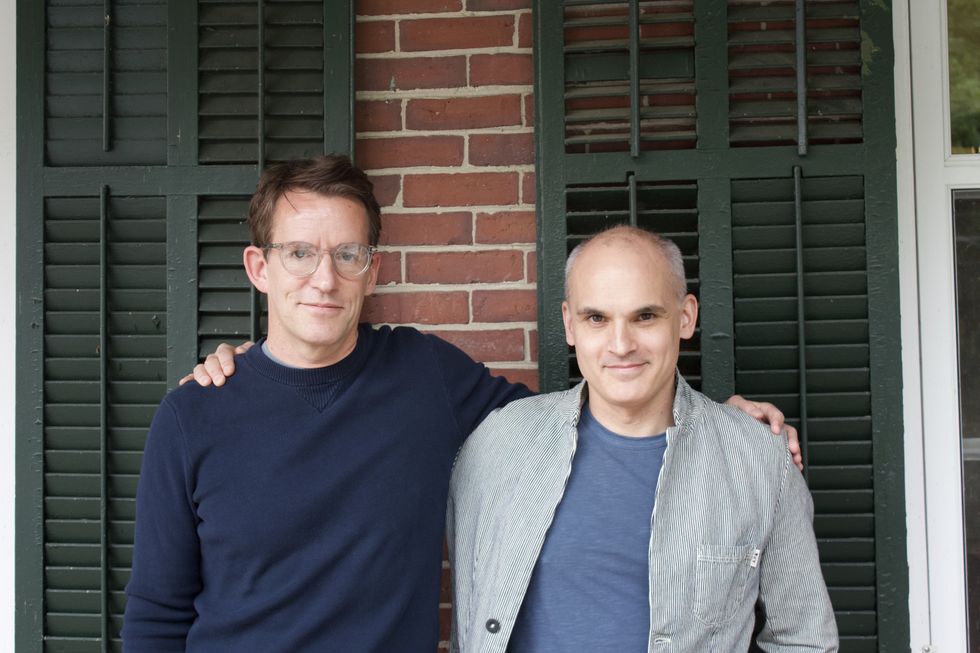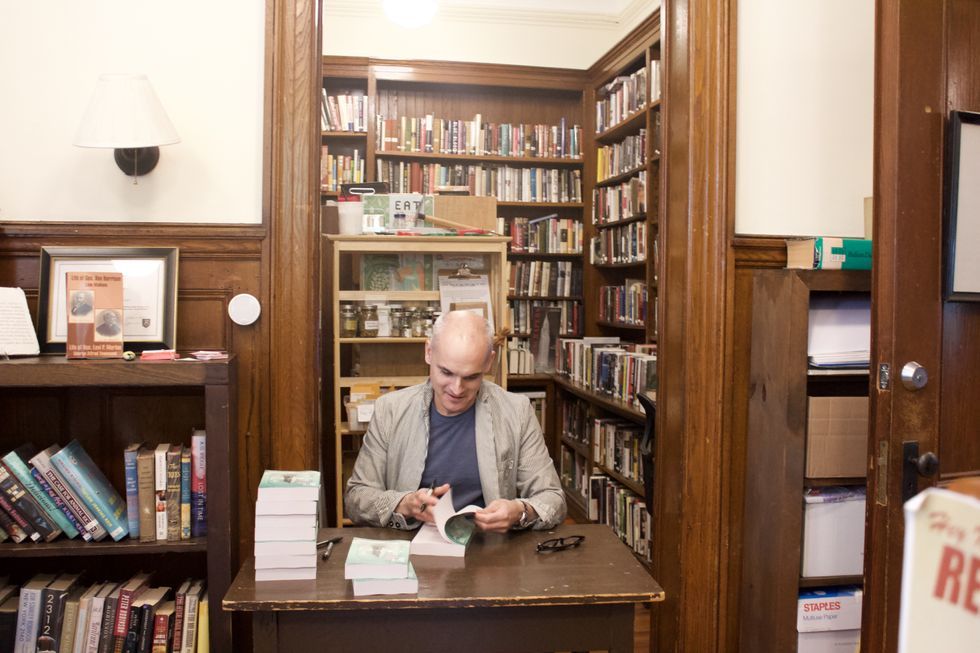Hernan Diaz's Path to Winning The Pulitzer

Bill Clegg and Hernan Diaz
Photo by Elias Sorich

Hernan Diaz, winner of the 2023 Pulitzer Prize for his novel “Trust,” began his conversation at the Morton Memorial Library in Rhinecliff, N.Y. on Tuesday, May 16 with a story about his upbringing. As a child, before he had the faculty to write, he’d drawn doodles which he would bring to his mother and say, “Look at what I’ve written, Mom!” Driven toward storytelling from that young age, Diaz’s path to the Pulitzer was one he described, with moving honesty, as frequently lonely.
Diaz was in conversation with Bill Clegg, his agent at the Clegg Agency and author of “Portrait of an Addict as a Young Man” among others. The two had a familiar and charming relationship. Clegg, a resident of Sharon, Conn., recounted the story of how he and Diaz had first met, when Diaz sent in his first unpublished manuscript. Clegg characterized that first book as “full of this blinding prose,” but decided not to take it on. Clegg sent out what Diaz called, “the nicest rejection letter I ever got.”
The next Clegg heard of Diaz was when the author’s first published novel (the second he had written), “In the Distance,” was put out by Coffee House Press in 2017. The book would go on to become a finalist for the Pulitzer and the PEN/Faulkner Award. Once Clegg read it, he called Diaz to congratulate him and comment on how genuinely stunning he’d found it. “I was so completely blown away,” Clegg said, which promoted Diaz’s response — “That’s so kind, when I sent it to you and didn’t hear back I assumed…” Clegg, still on the call (“I could actually hear his furious typing”), then frantically searched through his inbox, and found the unopened email with a submission of the manuscript from Diaz. It had come during a time when Clegg was changing agencies. “Hernan has since very graciously forgiven me.”
Responding in part to broader commentary around his seemingly meteoric rise in the literary world, Diaz spoke about the decades of his writing career that preceded success as often full of the “cold, dark” reality of rejection. Emphasizing that he is not unaffected by his circumstances, Diaz takes joy in the ways his writing life has changed, while also acknowledging the difficulty that came before.
“Being rejected for such a long time hurt. It made me feel crazy. Like I was still making those doodles.”
Through it all, Diaz is a writer genuinely in love with the process of writing. Coming from a “many-placed” upbringing — first in Argentina, then Sweden, then the United States — he described himself as a lover of the English language and syntax, proclaiming the sentence to be “the greatest technology humans ever produced.” Both in reading and writing, however, what Diaz seeks is the dissolution and melding of the self into something wider. “Sometimes when I write, I forget myself. What a wonderful thing that is.”
“Trust” is a novel Diaz characterized as polyphonic, and is composed of four separate, standalone “books” written in distinct styles, and from the perspective of intertwined characters. Its preoccupying theme is stratospheric wealth — but Clegg also framed the novel as a fundamentally feminist text, with Diaz stating that there are essentially “zero women in the history of the literature of wealth.” The Pulitzer Prize committee describes the book as, “At once an immersive story and a brilliant literary puzzle, ‘Trust’ engages the reader in a quest for the truth while confronting the deceptions that often live at the heart of personal relationships, the reality-warping force of capital, and the ease with which power can manipulate facts.”

Photo by Elias Sorich
The Community Closet at HVRHS is open for students to take clothes for any reason during the school day.
What started with one unexpected donation of clothes has grown into a quietly impactful resource for all students at HVRHS: the Community Closet. Now located in a spacious area above the cafeteria, the closet offers free clothing to any student for any reason.
The idea began a few years ago when a community member reached out to the former superintendent wondering if anyone at the school could benefit from used clothing that would otherwise go to waste. The superintendent then got in contact with Rachel Novak, the school social worker. “Once I had all those bags of clothes in my room, I was like, ‘I should put this in a space,’” Novak said. Her simple idea eventually became a full-sized closet accessible to all students.
From the beginning, Novak envisioned the closet as an inclusive space. “It’s open to anybody, it’s not just based on economic needs,” she said. Sustainability also plays a role. “Thinking about the environment, some students like to thrift and just get clothes that way,” Novak said.
After the initial donation, contributions continued to grow. “I reached out to our staff members and faculty,” Novak said. The most consistent donations come from the faculty at HVRHS and a few community members who learned about the closet. Finding teenage-appropriate clothes has been a challenge. “I get a lot of donations that are nice, but I don’t think teenagers would want to wear them,” Novak said.
Another ongoing obstacle has been awareness. Many students don’t know the closet exists at all. “That’s been the hard part,” Novak said. “Getting it out to the wider community of the school.” Novak is looking for students and staff to spread the word. “It helps because our school nurse knows and other faculty members,” she said. “When they know a student needs something, they just bring them up.”
Looking ahead, she hopes to promote the space more actively. “When we come back from this break, I do plan to … get fliers and all that up and going,” Novak said. There may even be an upcoming expansion — she has discussed the possibility of turning part of the area into a food pantry. “That would be more of a need-based system for students,” she said. “But right now, promoting it is where I’m at.”
The Community Closet is well-stocked currently. “Just because of the amount of clothes I have, I’m not accepting any more donations until I clear some stuff out,” Novak said. She is still willing to make room for more fashionable, teen-friendly items donated by students. “That way I’ll have more teenager approved clothes.”
Above all, she wants students to know that no one is limited to using the space. “Sometimes there’s a stigma around it … like, ‘I don’t need help. I don’t want to take away from anybody else that may need it,’” Novak said. Due to the amount of clothes, students should feel welcome to use the closet for any reason. Some students even grab items last minute for sports and activities. “It’s important for kids to know it’s for everyone.”
Whether a student wants to thrift clothes sustainably, forgot to pack clothes for an after-school practice, or is in need of a new outfit, the Community Closet is a resource for all.
Sophomore Eliana Lang enjoys her Housy Shack cookie.
Now in its second year, the Housy Shack is a hit among students. The special education department-run store that sells warm cookies, drinks and other snacks to students and teachers draws people to a room in the back hallway every time it’s open.
The smell of warm cookies welcomes visitors to the store with snacks, drinks and even Housy merchandise for sale. The cookies are definitely the favorite, sometimes lines go out the door to get one before they sell out.
The cookies are so popular that the store had to increase prices from 50 cents to a dollar and implement a four cookie per person maximum. The Shack sells about 40-100 cookies per day and has about 20-60 HVRHS customers visiting per day.
Julie Browning and Heather Strid, two of the HVRHS faculty members that help run the Shack, said their goal was to create real-world job experiences as well as real-world shopping experiences for students at HVRHS. “Learning the skills to work in the world can be taught in a classroom, but the lessons are more meaningful and valuable when they are applied in real work situations, which is what we create through the school store,” Browning said.
The original purpose for the store seems to be working, as several students are learning important skills. Students said the store taught them skills like counting money, checking inventory and cleanliness along with social skills and customer service that could help in the professional world after high school.

As the store quickly became a hit, organizers were faced with the challenge of finding funding. “When we started planning to start the school store two years ago we needed money to buy equipment, supplies and food to start it up but were not sure how to get it,” Browning said. “Mrs. Strid came up with the idea of applying for a grant from the 21st Century Fund to help us get started and they were so generous.” That grant has been crucial to the success and growth of the school store.
Not only does the Housy Shack benefit the special education department, students said it fosters a sense of community throughout the school. “School store cookies are my favorite thing ever. They brighten up my day,” said Eliana Lang, a sophomore at HVRHS. Dayana, one of the student staffers at the Housy Shack, said her favorite part of working in the school store is when students come in to make purchases. She enjoys talking to them and ringing up their orders on the cash register. The Housy Shack brings people together and offers the opportunity for students to connect with each other.
As the school year continues, the members of the school store look forward to expanding their inventory by creating and selling a variety of Housy merchandise — t-shirts, sweatshirts, water bottles, and more. “I have had several students put in requests for certain hats, key chains, etc. … so there will be more of that to come,” Browning said. Last school year, profits were all invested back into the school store. “This year we are hoping to make more of a profit and will look to use the money that we make for field trips, outings as well as opportunities to donate and give back to the community,” Browning said. They also would like to use the school store to fundraise for other causes. “Right now we are collecting donations for The Little Guild Animal Shelter, so if anyone has pet supplies they would like to donate please drop them off in exchange for a cookie,” Browning said.